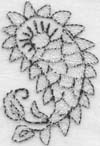Section 6 == *script chart*; *positional chart*; *more help*
6.1 == The letters kāf
and gāf
The letter kāf , "k," loses most of its flat hook in initial and medial forms, retaining only its vertical line and single slash-mark at the top. NOTE, however, that it has special combining forms for kāf plus alif and kāf plus lām . These are not entirely obvious to the intuition, but MUST be carefully learned whether they seem logical or not.
The letter gāf , "g," is simply a kāf with an extra slash-mark at the top. Everything said about kāf applies to it as well, including the point about the two special combining forms, which in this case are of course gāf plus alif and gāf plus lām .
Both initialkāf and initial gāf are commonly written calligraphically in such a way that the single slash-mark (I call it a 'flipper')-- or the lower one, in the case of a gāf -- looks like part of the vertical line, as if it would be written first, after which the pen would move downward into the vertical line. This impression however is wrong: it is only an illusory effect produced in certain fancy and much-admired calligraphic styles. If one actually wrote that way--incorporating the (lower) 'flipper' into the letter at the time of writing-- the result would be to guarantee bad and slow handwriting. Remember that the 'flipper(s)' above kāf and gāf are like the cross on a "t" in English-- they are completely separate, and are added after the whole word or letter-group has been written.
The letter lām , "l," loses its large rounded bottom in initial and medial forms, and remains a simple vertical line. You might at first think you could confuse it with alif , but you really can't, because lām is a connector and alif is a non-connector.
There's a special connecting form for lām plus alif , which also must be learned uniquely: the alif seems to sit in the lap of a lām with a minimized curve that sits on the line.
